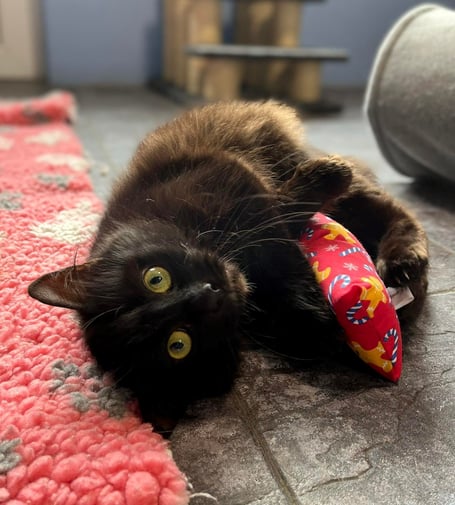The lead-up to Halloween, or Hop Tu Naa, is a time when we turn our minds to black cats as images and decorations depicting these iconic felines appear in homes and shops. Indeed, ‘National Black Cat Day’ was on October 27, and the whole month of October has been claimed as ‘Black Cat Awareness Month’ – so let’s celebrate this colour of cat, not least because it is sometimes associated with bad luck.
Conversely, in many cultures black cats are associated with good luck and they are seen as a good omen – a black cat appearing on your doorstep signals prosperity (a common belief in Scotland), and a black cat crossing your path signals good fortune (in England and Ireland).
But in much of the western world black cats are considered to be harbingers of misfortune and wickedness, due in the main to their association with witches and Satan.
In the 17th century simply owning a black cat could lead to harsh punishments, even death, because of their supposed links with witchcraft.
The black cat still suffers from, as the ‘National Black Cat Day’ website calls it, the ‘consequences of a damaged collective reputation’ which is why celebrating the black cat is a great opportunity to subvert trends and false beliefs.
Black cats could, themselves, do with some good luck.
They are two thirds less likely to be adopted than white cats, and 50% less likely to be adopted than tabbies.
They are also more likely to be involved in a road traffic accident because they are less visible to drivers, particularly at this time of year as the nights draw in at rush hour.
Another reason given for black cats being overlooked when it comes to adoption is that they can be difficult to photograph (an issue for some people in this social media, image savvy world we live in) but a shiny black cat can be very photogenic.
In fact, most black cats are not completely black, and they can have feint stripes or speckles in their coats.
They also change colour in the sun – ‘rusting’ is where, in bright sunlight, a black cat can appear to be a reddish-brown colour.
And what’s more, a dark coat places greater focus on a cat’s eyes, which are often a rich gold or green due to their higher melanin content.
A black cat is also likely to be healthier than its counterparts.
Research has shown that the genetic mutations that cause cats to have black coats may offer them some protection from diseases such as cancer and the feline equivalent of Alzheimer’s.
And on a very practical note, black hairs don’t show up as much as lighter coloured ones on our clothing and soft furnishings!
You can pretty much guarantee that we will have a black cat in our cattery looking for a new home all year round, and we have several to choose from at the moment, including Dior.
She is two years old but looks very kittenish, and she has a fluffy coat – something in between short and long hair.
She’s a true Manx cat with the vestige of a tail, but she hasn’t shown any health issues as a result of this.
She came to us as a semi-feral cat, but it hasn’t taken long to get more comfortable with humans.
She’s shy when you first meet her, but soon wants to play and interact with her two-legged friends.
Dior adores the catnip ‘playrolls’ that are hand-made and then regularly donated to the cattery by Sandra Caley, and she has endless fun with them.
Some cats respond more than others to catnip, but most of them thoroughly enjoy their ‘playrolls’ and they, quite literally, play cat and mouse with them.
Dior will need a semi-rural new home with plenty of outdoor space to explore.
She’s lived with other cats and she would probably cope quite well with children as long as they respected her boundaries.
If you would like to meet her, or any of our other cats (black or not), please contact the cattery on 851672, option 2.

.jpeg?width=209&height=140&crop=209:145,smart&quality=75)

.png?width=209&height=140&crop=209:145,smart&quality=75)

Comments
This article has no comments yet. Be the first to leave a comment.